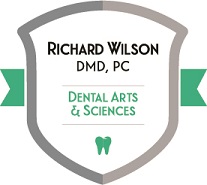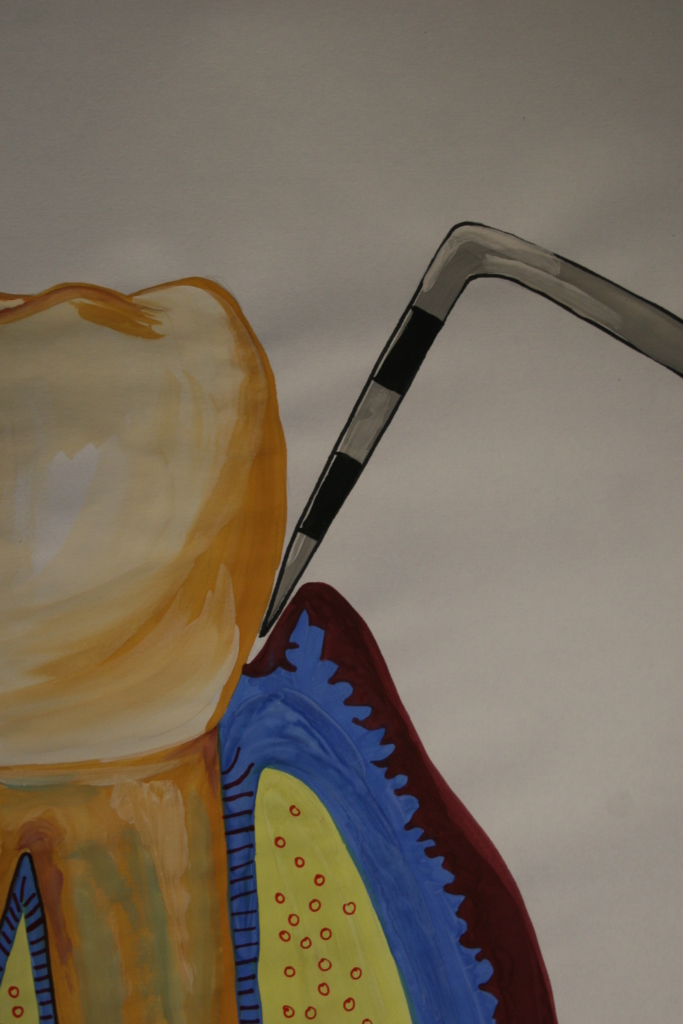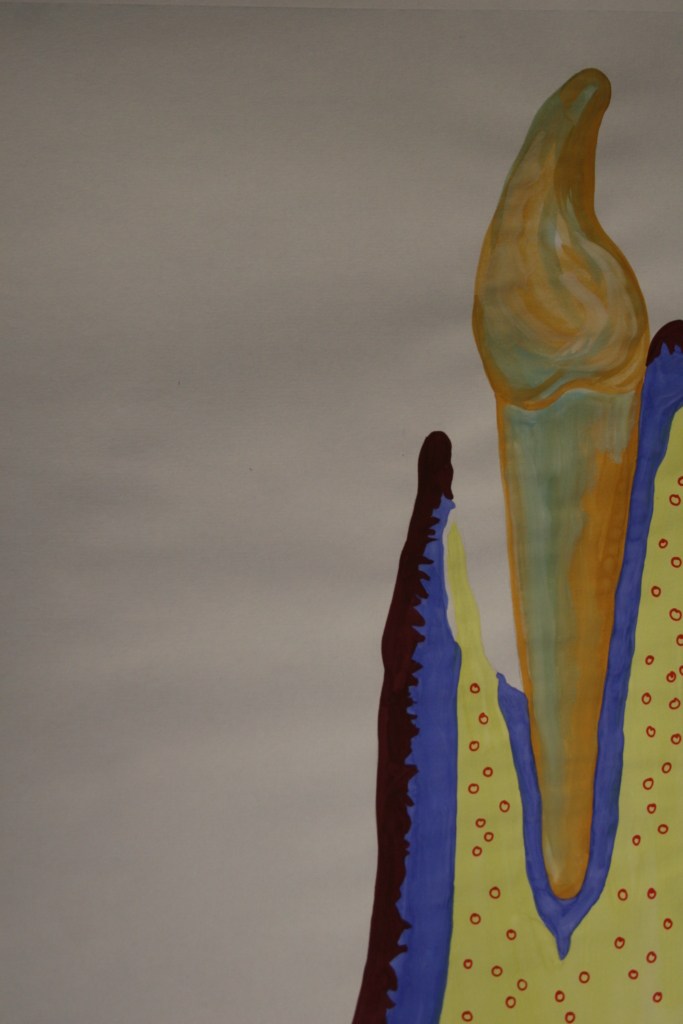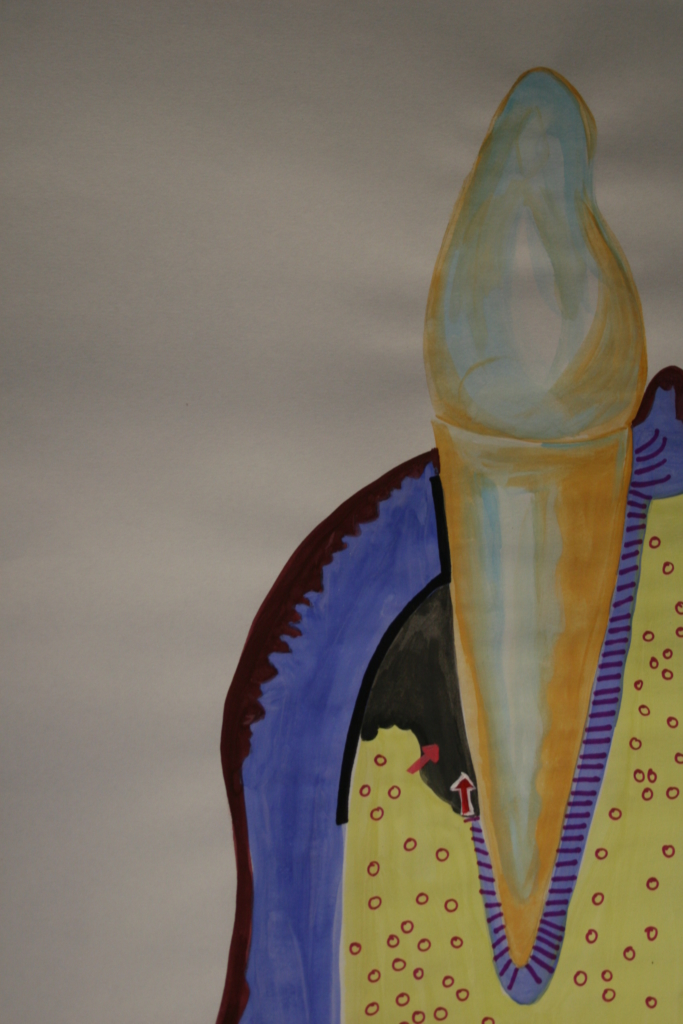Surgical Periodontal Treatment
This beautiful Alicia Falco painting shows a tooth and its surrounding gums and bone in a state of health. Adjacent to the tooth we see the supporting bone in yellow. The overlying surface covering of the gums is in red, and the deeper connecting tissues are in blue. The blue band with the parallel lines radiating out from the tooth root represents the ligament that holds the tooth to the bone. Yes, it’s not simply tooth to bone–there’s a ligament that connects them, providing cushioning movement, sensation (in case we bite on something too hard) and also the ability to move teeth with orthodontics.
When I was at Penn Dental, my dean was the brilliant Swedish periodontal researcher Jan Lindhe, and along with him from Gothenburg came Sture Nyman. Naturally, his grad students nicknamed him “Suture Nyman.”
And my word, weren’t we lucky to learn from this extraordinary scientist.
You see, for a very long time, when those dangerous pockets under the gums became too deep, the only known treatment was to cut the gums away, so the pockets would be shallow again. “Longer teeth or teeth no longer” was the old catchphrase. It did not make patients feel better about the whole thing, I’m sure. Ugly long roots exposed, untreatable root sensitivity–all in all, not a fun outcome to contemplate.
In the face of all this excision, Dr. Nyman was interested in regeneration. He started with the fundamental biology of the situation. He recognized that only four tissues can potentially be involved in healing after periodontal treatment of any type: epithelium (the outer layer of gums, red in our picture), connective tissue (deeper layers of gums, blue), bone (yellow), and the periodontal ligament (the lines between tooth and bone), the structure that actually attaches our teeth to their supporting jawbone.
Dr. Nyman found that during healing after all types of gum treatment for bone loss, it’s a race between these four tissues. And the fastest runner is, as we would expect, the surface covering. The gums. This makes sense, because any time we are wounded anywhere on our body, the surface–skin, gums, and so on–is the most important barrier against the many germs that mean us harm.
In the above picture, bone loss has left a long, long section of root exposed down the outside of this tooth. After conventional treatment, the gums will race to fill the gap but … we unfortunately still have the loss of bone and support for this tooth. Even worse, a lot of that damaged bone will “melt away” during the healing process; it simply doesn’t have enough support to survive.
Thus, the problem with this healing mechanism around teeth is that if gums win the race to heal, we never get back the original attachment of tooth-to-ligament-to-bone. What we end up with is something weak and very prone to breaking down again. So when the gums win the race, more periodontal disease is almost inevitable.
Sture Nyman was the first to achieve regeneration of gums and bone by placing a barrier to the fast-healing gum tissues. After lifting back the intact gum tissues and meticulously cleaning the roots of the diseased teeth, he placed a millipore membrane (represented in black in the next photo) over the area of damaged/missing bone. This is essentially a piece of cloth-like material with very specific sized holes in it–holes small enough to keep out entire cells, but large enough to allow the flow of nutrients and all the healing factors that the body produces.
When he removed the membrane a few weeks later, he saw new bone in the previously damaged site. Lots of it.
In the years since we have seen a proliferation of all manner of bone grafting materials, growth factors, membranes and other adjuncts in the quest for ideal periodontal regeneration. In the end, though, all that really matters is keeping out the fast gum tissues and preventing new germs from attacking the healing site. Bone is a very non-specific tissue. If we give a healing site in the jaw its space, bone will form there again. What else could possibly end up there? Liver? An appendix? Of course not. We will always get bone, if we provide the right conditions. It’s the gums that provide the barrier against further infection and breakdown–the gums are the key tissue here. We merely need to contain them–just enough–so that they can do their job, but not heal the site first.
Periodontal regeneration is not yet a perfect system. We can repair small, acutely damaged sites much more effectively than large, blown-away ones. Further, in patients where gum disease has damaged all their teeth, it is not yet possible to “grow it all back.” It’s also extremely challenging to re-create the nicely scalloped gums around upper front teeth after they have been heavily damaged by periodontal disease, and this remains a challenge because gums are such an important part of our smiles. Still, the ability to build back gums and bone, however limited, is far better than the crude cutting-away from the old days.
The images above are from hand-painted works by our dental assistant and remarkable artist Alicia Falco.
In our final installment on preventing periodontal disease, we will get back to basics and talk about brushing and (gasp!) flossing.
http://www.smilephiladelphian.com/how-do-i-best-clean-my-teeth/




